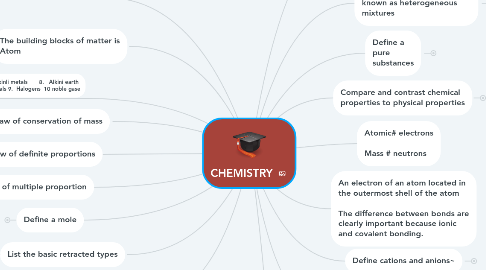CHEMISTRY
by Jacob Castillo

1. The building blocks of matter is Atom
2. Four states of matter Liquid Gas Solid Plasma
3. 7.alkinli metals 8. Alkini earth Metals 9. Halogens 10 noble gase
3.1. Periodatic table
4. Define law of conservation of mass
4.1. he law of conservation of mass or principle of mass conservation states that for any system closed to all transfers of matter and energy, the mass of the system must remain constant over time, as system's mass cannot change, so quantity cannot be added nor removed
5. Law of definite proportions
5.1. In chemistry, the law of definite proportion, sometimes called Proust's law or the law of definite composition, or law of constant composition states that a given chemical compound always contains its component elements in fixed ratio (by mass) and does not depend on its source and method of preparation
6. Law of multiple proportion
6.1. In chemistry, the law of multiple proportions is one of the basic laws of stoichiometry used to establish the atomic theory, alongside the law of conservation of mass and the law of definite proportions~~~~~
7. Define a mole
7.1. he mole is the unit of amount in chemistry. ... A mole of a substance is defined as: The mass of substance containing the same number of fundamental units as there are atoms in exactly 12.000 g of 1
8. Explain the octet rule
8.1. The octet rule is a chemical rule of thumb that reflects observation that atoms of main-group elements tend to combine in such a way that each atom has eight electrons in its valence shell, giving it the same electron configuration as a noble gas
9. List the basic retracted types
9.1. Combination. • Decomposition. AB>A+b • Single displacement.AX+B> a + by • Double displacement. AX+BY>AY+BX • Combustion. Oxygen has to be there
10. Define stiochiometry
10.1. the relationship between the relative quantities of substances taking part in a reaction or forming a compound, typically a ratio of whole integers
11. Compare and contrast chemical properties to physical properties
11.1. A physical property is an aspect of matter that can be observed or measured without changing its chemical composition. Examples of physical properties include color, molecular weight and volume. A chemical property may only be observed by changing the chemical identity of a substance
12. Atomic# electrons Mass # neutrons
13. Define and example homogeneous and heterogeneous
13.1. A homogeneous mixture is simply any mixture that is uniform in composition throughout.~~~A heterogeneous mixture is simply any mixture that is not uniform in composition - it's a non-uniform mixture of smaller constituent parts. Using various means, the parts in the mixture can be separated from one another.
14. Mechanical mixtures are also known as heterogeneous mixtures
14.1. Examples: Homogeneous: milk, kool-aid, blood, lotion, window cleaner, glue, etc. Heterogeneous: pizza, cereal and milk, rocks in the sand at the beach, banana splits, etc.
15. Define a pure substances
15.1. pure-substance or chemical substance is a material that has a constant composition (is homogeneous) and has consistent properties throughout the sample. ... All elements are pure substances
16. An electron of an atom located in the outermost shell of the atom The difference between bonds are clearly important because ionic and covalent bonding.
17. Define cations and anions~
17.1. Cations and anions are both ions. The difference between a cation and an anion is the net electrical charge of the ion. Ions are atoms or molecules which have gained or lost one or more valence electrons giving the ion a net positive or negative charge
18. How are a cations and anions created
18.1. Cations (positively-charged ions) and anions (negatively-charged ions) are formed when a metal loses electrons, and a nonmetal gains those electrons. The electrostatic attraction between the positives and negatives brings the particles together and creates an ionic compound, such as sodium chloride.


